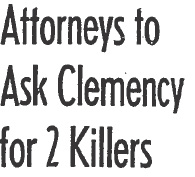Their failure to solve the June 22, 1947 murder of Bugsy Siegel still rankled members of the Beverly Hills Police Department. None of them wanted to suffer the frustration of another high profile cold case. They were committed to solving Katie Hayden’s murder and they weren’t above asking for help. Many of the smaller Los Angeles county police departments, like Beverly Hills, were unaccustomed to conducting murder investigations so they enlisted the aid of the Los Angeles County Sheriff’s Department homicide bureau.

Rutherford Leon Bennett (R) and Nathaniel Smith (L). Photo courtesy of LAPL.
Despite his protestations of innocence, Rutherford Leon Bennett was a promising suspect. The Hayden’s had recently dismissed Rutherford as their cook when he failed to perform to their expectations. He said he phoned Samuel Hayden for a reference, but his call could have been interpreted as an attempt to extort money from his former boss for his firing. Rutherford was arrested and booked on suspicion of murder. His roommate, Nathaniel Smith, was taken into custody but released after an intense interrogation proved that he had no part in the crime.
Rutherford submitted to a lie detector test. He passed, but that wasn’t enough to satisfy the police. There are people who can defeat a polygraph – maybe Rutherford was one of them. Police weren’t about to kick him loose unless or until they had a better suspect.

Margaret and Rutherford. Photo courtesy LAPL.
Peggy King, Rutherford’s replacement as the Hayden’s cook, was an obvious suspect because she was the only person in the house when Katie was murdered. But where was her motive? She had only been in the Hayden’s employ for three days.
Police learned that Peggy was also known as (Mrs.) Margaret Moore. Margaret was a relative newcomer to Los Angeles. She left her home in Houston, Texas in 1954 following a separation from her husband. Her father, Samuel Johnson, was a prominent figure in Houston’s Baptist church community. Nothing in Margaret’s background marked her as someone capable of hacking her employer to death with a hatchet. Still, police were obliged to subject her to the same scrutiny they gave Rutherford.
Detective Sergeant Ray Hopkinson of the Los Angeles County Sheriff’s homicide bureau assisted in the investigation. He said that one of Margaret’s male friends, with whom she had recently quarreled, had been located and was able to account for his whereabouts. One more suspect eliminated.
The police weren’t entirely satisfied with Margaret’s description of events. Since there was no one who could confirm or deny her story the police had to find another way to get at the truth. In her closet they found the dress that Margaret was wearing the day of the murder. It was spattered with what appeared to be blood. Even if the blood was Katie’s, it didn’t necessarily mean that Margaret was a killer.
Margaret’s alibi, that she had been vacuuming in another part of the house while Katie was being butchered, didn’t hold together when police realized that the killer would have had to pass Margaret to get to Katie.
Margaret had a date with the polygraph machine on February 11, 1955. Investigators hoped that the polygraph, the ultimate truth or dare device in a murder investigation, would reveal Margaret’s lies — if she was telling any. The former cook was questioned for over 90 minutes. The examiner concluded that Margaret was being deceptive in her answers.
Detectives used Margaret’s lies against her. It didn’t take long for her to break down and confess. But why had she done it?

Margaret. Photo courtesy LAPL.
According to Margaret the murder was the result of a heated argument she had with Katie about how to bone a roast. Katie was supervising Margaret in the kitchen and lost patience with her. In a fit of pique Katie snatched the small ax Margaret was using out of her hands and attempted to give her a demonstration.
“I had gotten the ax to cut the bone in the roast. During the argument Mrs. Hayden took the ax from me and tried to show me how to do it.” Margaret said.
“She (Katie) continued arguing with me and then I took the ax from her and struck her on the head. She didn’t fall after I struck her once and then I struck her again and again. I don’t know how many times I struck her after that. . .”
Margaret may have lost count of the blows it took to shatter Katie’s skull, but Dr. Newbarr, who conducted Katie’s autopsy, said that the sharp end of the ax had been used to inflict 20 to 30 cuts to her head and face. Then the butt end of the ax was used to fracture her lower left jaw and her upper left collarbone.
The vicious attack sent Katie to the kitchen floor in a bloody heap. “I stood over her for more than 10 minutes,” Margaret said. “I was dazed.”
She wasn’t too dazed to formulate a plan to escape detection. As Katie lay dying in a widening pool of blood, Margaret went upstairs and ransacked her employer’s room. “I opened all the drawers in the dressers and scattered clothing about the floor to make it appear that someone had broken in the house,” she told detectives.
While Margaret was yanking out dresser drawers and throwing clothing around Katie’s room, the telephone rang. The caller was one of Katie’s daughters, Rose Furstman. Margaret answered the phone and told her that someone had come in and killed her mother. Then she hung up. Rose lived at 1041 Hilts Avenue in West Los Angeles, barely two miles away from her parents’ home. It must have been an agonizing drive over to her parent’s home.
Margaret used the few minutes before Rose arrived to wipe her bloody hands clean with a dust rag. She tossed the rag and the ax into the kitchen sink, then she began to scream.
Margaret’s unholy wailing drew the attention of the half a dozen landscapers that were in the Hayden’s backyard installing a sprinkler system. When they got to the kitchen they found Margaret standing near Katie’s body. There was blood everywhere.
Margaret’s explanation for the murder was that her nerves were on edge because her common-law husband of two years had left her. Margaret’s two-year relationship was nothing compared to the 49 years that Samuel and Katie had spent together. The couple would have celebrated their 50th wedding anniversary in August.

Margaret comforted by her brother, Milton Johnson. Photo courtesy LAPL.
Roy King, the man Margaret called husband, showed up at the Beverly Hills Jail to comfort her. Her brother, Milton Johnson, also came to the jail to show support.
With Margaret’s confession in hand the cops breathed a sigh of relief. Their part was done. Now it was up to the courts to decide her fate.
There was talk of an insanity plea, so Dr. Marcus Crahan, County Jail psychiatrist, examined Margaret. After questioning her for 45 minutes Crahan said: “She is normal mentally.”

Margaret in tears. Photo courtesy LAPL.
With the confession and Dr. Crahan’s report against her, Margaret appeared before Judge Stanley Mosk and withdrew her earlier plea of innocent by reason of insanity and waived her right to a jury trial. It was a smart move, she likely would have fared much worse with a jury than she did with Judge Mosk. He heard the case without a jury and found Margaret guilty of second degree murder and sentenced to a term of from five years to life in state prison.

 Ewing Scott was released from prison in 1974, still vehemently denying that he had murdered his wife Evelyn in 1955.
Ewing Scott was released from prison in 1974, still vehemently denying that he had murdered his wife Evelyn in 1955.

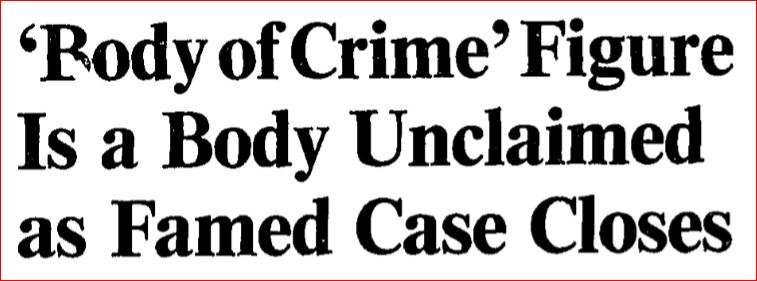 On August 17, 1987, ninety-one year-old Ewing Scott died at the
On August 17, 1987, ninety-one year-old Ewing Scott died at the  Ewing’s attorneys told reporters they were worried that their client had met with “foul play”. Both the police and the district attorney were convinced that Ewing’s convenient disappearance was a hoax.
Ewing’s attorneys told reporters they were worried that their client had met with “foul play”. Both the police and the district attorney were convinced that Ewing’s convenient disappearance was a hoax.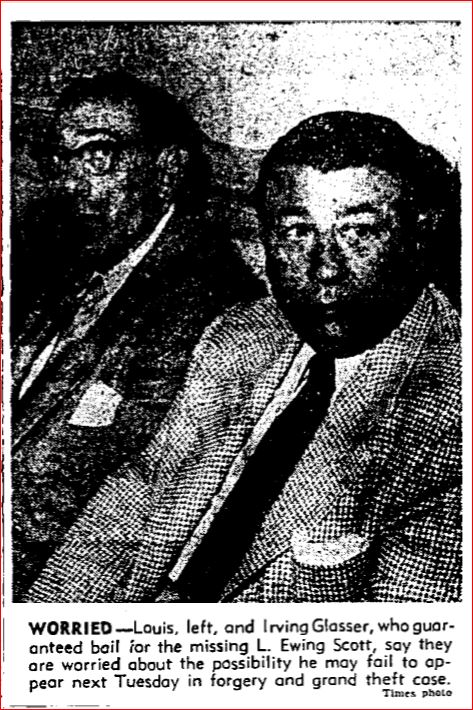 So, was Ewing sitting on a distant beach sipping a cocktail with a colorful little umbrella in it; or was he dead and buried in an unmarked shallow grave along Angelus Crest Highway? Nobody knew for sure.
So, was Ewing sitting on a distant beach sipping a cocktail with a colorful little umbrella in it; or was he dead and buried in an unmarked shallow grave along Angelus Crest Highway? Nobody knew for sure.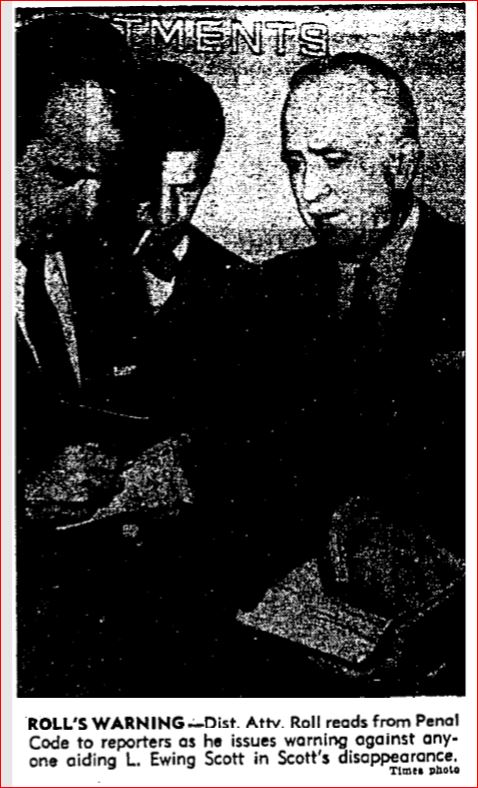
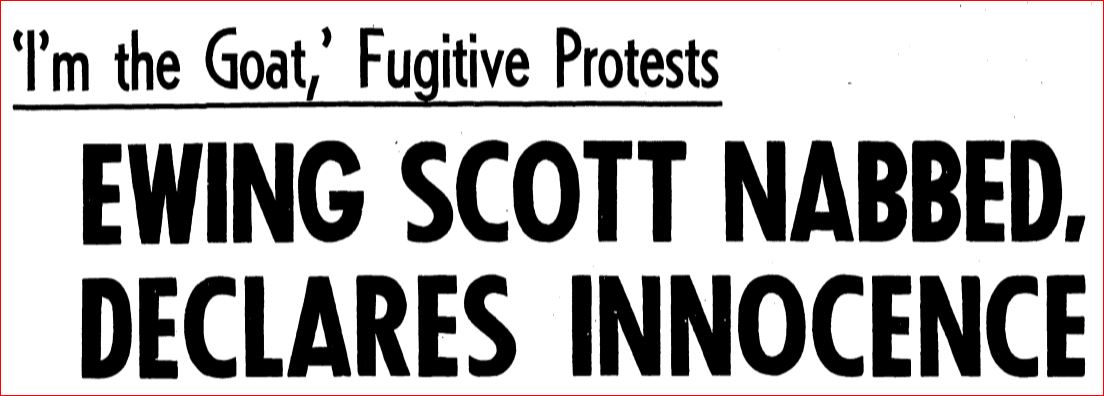
 Ewing was charming and friendly during his interview until a reporter asked him point-blank if he had murdered his wife. Scott replied, “That is an asinine question. It is just plain ridiculous and stupid. It is the last thing I would want to do.”
Ewing was charming and friendly during his interview until a reporter asked him point-blank if he had murdered his wife. Scott replied, “That is an asinine question. It is just plain ridiculous and stupid. It is the last thing I would want to do.” As far as any possible film, the charming, sophisticated and good looking English actor, Ronald Colman, seemed to Ewing to be the obvious choice to portray him on the big screen. Who would play Evelyn? Ewing wasn’t so sure. “As far as Mrs. Scott goes, I don’t know who would be exactly right. perhaps an older Peggy Lee, or Mary Astor. I’d have to see the woman first.” After further thought, Ewing said about the as yet unnamed actress, “I do know that she’ll have to be smart, dignified and rather good looking–and definitely not the wisecracking type.” Okay. I guess Joan Blondell wouldn’t be considered — although personally I think she would have been a fantastic choice.
As far as any possible film, the charming, sophisticated and good looking English actor, Ronald Colman, seemed to Ewing to be the obvious choice to portray him on the big screen. Who would play Evelyn? Ewing wasn’t so sure. “As far as Mrs. Scott goes, I don’t know who would be exactly right. perhaps an older Peggy Lee, or Mary Astor. I’d have to see the woman first.” After further thought, Ewing said about the as yet unnamed actress, “I do know that she’ll have to be smart, dignified and rather good looking–and definitely not the wisecracking type.” Okay. I guess Joan Blondell wouldn’t be considered — although personally I think she would have been a fantastic choice.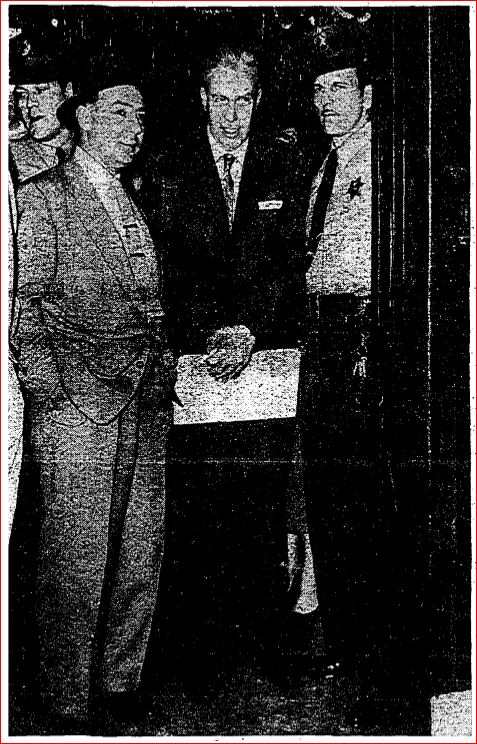 Despite the lack of a physical body, Deputy District Attorney J. Miller Leavy, was confident that the corpus delicti of murder could be established. There was a mountain of compelling circumstantial evidence to bolster the State’s case. Leavy was not only certain of a conviction, he asked for the death penalty.
Despite the lack of a physical body, Deputy District Attorney J. Miller Leavy, was confident that the corpus delicti of murder could be established. There was a mountain of compelling circumstantial evidence to bolster the State’s case. Leavy was not only certain of a conviction, he asked for the death penalty.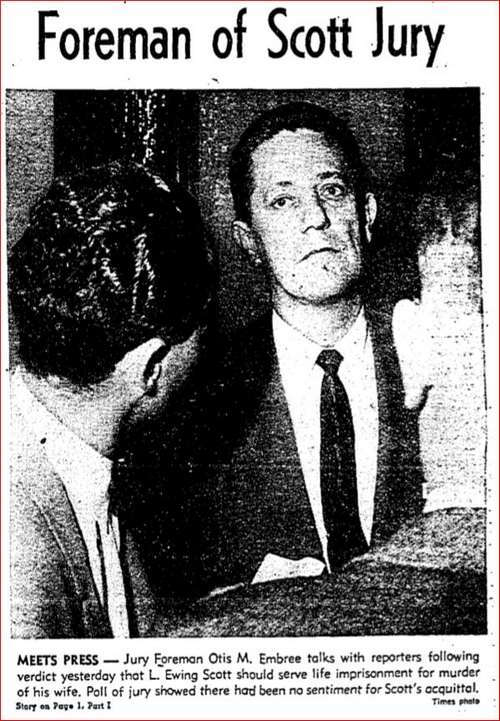 Several days later, following four hours of deliberation, the jury returned with their sentence: life in prison.
Several days later, following four hours of deliberation, the jury returned with their sentence: life in prison.
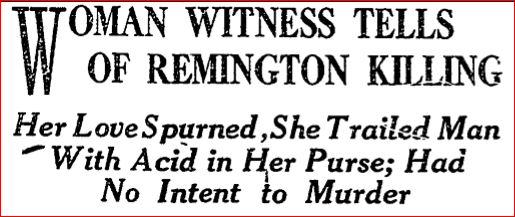 According to Hahn, the woman (whom Hahn described as an attractive 28-year-old brunette) said she and Earle had been lovers for more than eighteen months, but his interest in her began to wane. She tried unsuccessfully to hold on to him. The woman told Hahn: “I loved Remington and expected him to marry me. I first began to share his love more than a year and a half ago. I had been married. I knew he was married, but he promised that he would obtain a divorce and marry me. For a year we were happy. He and I lived together for a time at the beach at Venice. Then gradually his love seemed to cool. He missed his appointments with me and I say less and Less of him.”
According to Hahn, the woman (whom Hahn described as an attractive 28-year-old brunette) said she and Earle had been lovers for more than eighteen months, but his interest in her began to wane. She tried unsuccessfully to hold on to him. The woman told Hahn: “I loved Remington and expected him to marry me. I first began to share his love more than a year and a half ago. I had been married. I knew he was married, but he promised that he would obtain a divorce and marry me. For a year we were happy. He and I lived together for a time at the beach at Venice. Then gradually his love seemed to cool. He missed his appointments with me and I say less and Less of him.” Two months turned into two years, then twenty. It has now been nearly 95 years since Earle was murdered in the driveway of his home. Yet, there was a brief glimmer of hope when a WWI veteran, Lawrence Aber, confessed. His reason? He said he was angry at Earle for selling liquor to veterans. It didn’t take long for the police to realize that Aber had lied. He wasn’t being malicious, he suffered from severe mental issues and he was in a hospital at the time of the slaying.
Two months turned into two years, then twenty. It has now been nearly 95 years since Earle was murdered in the driveway of his home. Yet, there was a brief glimmer of hope when a WWI veteran, Lawrence Aber, confessed. His reason? He said he was angry at Earle for selling liquor to veterans. It didn’t take long for the police to realize that Aber had lied. He wasn’t being malicious, he suffered from severe mental issues and he was in a hospital at the time of the slaying.

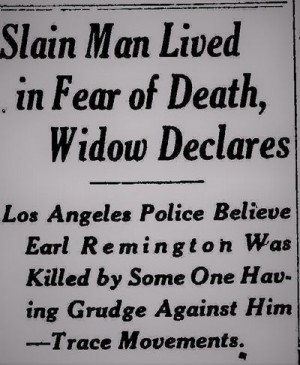 Less than a week into the investigation police discovered that Earle was the victim of extortion — a blackmail scheme run by a man and woman. The woman had allegedly seduced Earle then told him it would cost him big time for her to keep her mouth shut about their affair.
Less than a week into the investigation police discovered that Earle was the victim of extortion — a blackmail scheme run by a man and woman. The woman had allegedly seduced Earle then told him it would cost him big time for her to keep her mouth shut about their affair.

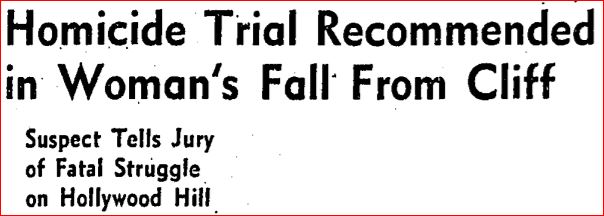 At the Coroner’s inquest Dr. Frank R. Webb, autopsy surgeon, testified that Pearl had died of a skull fracture and that her blood alcohol level was .22, enough for her to be intoxicated.
At the Coroner’s inquest Dr. Frank R. Webb, autopsy surgeon, testified that Pearl had died of a skull fracture and that her blood alcohol level was .22, enough for her to be intoxicated.
 Close on the heels of the first man’s visit to Cote’s home another young man, twenty year-old Alfred Dobriener of
Close on the heels of the first man’s visit to Cote’s home another young man, twenty year-old Alfred Dobriener of  Detective Lieutenant S.R. Lopez of the the LAPD said that Pearl had either gone to the end of the bus line and hiked up Franklin to take in the view alone, or she had ridden up in the car with the two men to the top of the hill. By virtue of its seclusion and spectacular views the spot was a local lover’s lane. But why would Pearl have gone there with two men?”
Detective Lieutenant S.R. Lopez of the the LAPD said that Pearl had either gone to the end of the bus line and hiked up Franklin to take in the view alone, or she had ridden up in the car with the two men to the top of the hill. By virtue of its seclusion and spectacular views the spot was a local lover’s lane. But why would Pearl have gone there with two men?”
 Gray’s mother, Lola, remained at her son’s bed side and on August 24th it was reported that she had given her official consent for an operation to remove the bullet from his brain. It isn’t clear why a man in his 30s would need his mother’s consent, but it may have been that he was in no condition to give it himself. S.S. Hahn told the court that in his present condition Gray was in imminent danger of death and that, even if he survived, he might be become “an imbecile.” The operation was given odds of 100 to 1 that it would succeed; but it was Gray’s only hope.
Gray’s mother, Lola, remained at her son’s bed side and on August 24th it was reported that she had given her official consent for an operation to remove the bullet from his brain. It isn’t clear why a man in his 30s would need his mother’s consent, but it may have been that he was in no condition to give it himself. S.S. Hahn told the court that in his present condition Gray was in imminent danger of death and that, even if he survived, he might be become “an imbecile.” The operation was given odds of 100 to 1 that it would succeed; but it was Gray’s only hope.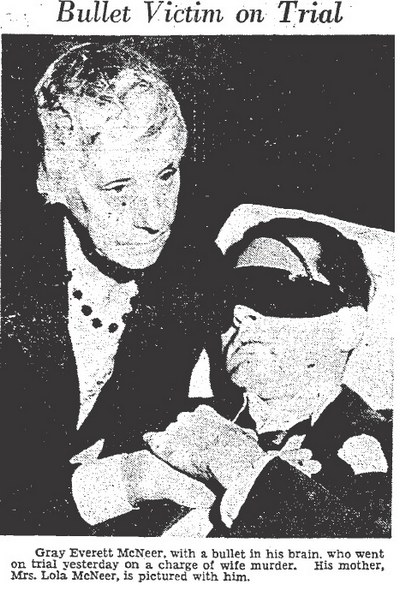 Hahn objected to the Judge’s admonition and there was a short recess. Once back in the courtroom, Judge Burnell spoke to the jury: “Ladies and gentlemen of the jury, I am making this statement to you at the suggestion and with the consent of counsel for both sides, the People and the defendant. You, of course, could not help but observe the fact yesterday afternoon that the defendant was making more or loess noise, talking and groaning, and the Court made some remarks about ceasing the theatricals, or something of that sort. That, of course, is something that you haven’t any business to pay any attention to, and I want you to entirely disregard it. The defendant is here on trial for one specific offense, and all the jury have any right to consider whatever is the evidence in the case and nothing else. I know you will appreciate that and be able to do that, but for your information, in view of the apparent condition of the defendant, I am trying now to get hold of Dr. Blank, the jail physician, to come down here and tell us whether he thinks from his examination of the defendant there is any reason why the case should not continue. In other words, whether or not the defendant is in a condition physically and mentally that will preclude going ahead with the trial. Until we hear from Dr. Blank, we will go ahead, and if there is any demonstration on the part of the defendant, you will disregard it. You are not here to try anything except the facts in this case.”
Hahn objected to the Judge’s admonition and there was a short recess. Once back in the courtroom, Judge Burnell spoke to the jury: “Ladies and gentlemen of the jury, I am making this statement to you at the suggestion and with the consent of counsel for both sides, the People and the defendant. You, of course, could not help but observe the fact yesterday afternoon that the defendant was making more or loess noise, talking and groaning, and the Court made some remarks about ceasing the theatricals, or something of that sort. That, of course, is something that you haven’t any business to pay any attention to, and I want you to entirely disregard it. The defendant is here on trial for one specific offense, and all the jury have any right to consider whatever is the evidence in the case and nothing else. I know you will appreciate that and be able to do that, but for your information, in view of the apparent condition of the defendant, I am trying now to get hold of Dr. Blank, the jail physician, to come down here and tell us whether he thinks from his examination of the defendant there is any reason why the case should not continue. In other words, whether or not the defendant is in a condition physically and mentally that will preclude going ahead with the trial. Until we hear from Dr. Blank, we will go ahead, and if there is any demonstration on the part of the defendant, you will disregard it. You are not here to try anything except the facts in this case.” Why was Marion on a crime spree? He told reporters: “I wanted to commit self-destruction in such a way my insurance policy would not be invalidated through the suicide clause.” Suicide by cop would have been his parents the princely sum of $1200 (equivalent to $20,814.77 in current USD). No doubt the cash would have helped his family weather the Depression. Marion entered a guilty plea, but a few days later he reappeared in court and changed his plea to innocent. He was placed on probation for 2 years.
Why was Marion on a crime spree? He told reporters: “I wanted to commit self-destruction in such a way my insurance policy would not be invalidated through the suicide clause.” Suicide by cop would have been his parents the princely sum of $1200 (equivalent to $20,814.77 in current USD). No doubt the cash would have helped his family weather the Depression. Marion entered a guilty plea, but a few days later he reappeared in court and changed his plea to innocent. He was placed on probation for 2 years.
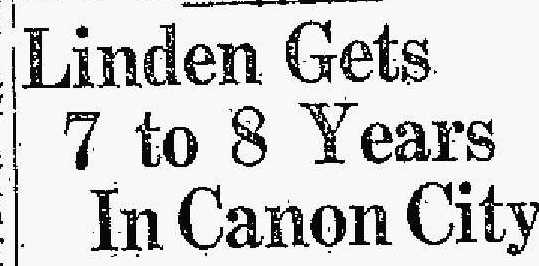 Marion was convicted of voluntary manslaughter. Judge Henry A. Hicks pronounced sentence–from seven to eight years in the state penitentiary. Lewis D. Mowry, Marion’s attorney, said that the his client had no plans to appeal, nor would he seek a new trial.
Marion was convicted of voluntary manslaughter. Judge Henry A. Hicks pronounced sentence–from seven to eight years in the state penitentiary. Lewis D. Mowry, Marion’s attorney, said that the his client had no plans to appeal, nor would he seek a new trial.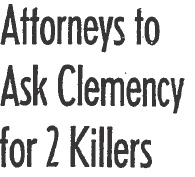 In 1959 Allen owned a small jewelry and watch repair shop at 7715 Hollywood Way in the San Fernando Valley. The former Kansas farm boy was the father of two, a WWII veteran and former pilot who had spent five years in uniform before being honorably discharged. When he was mustered out of the service he took courses in watch and jewelry repair then opened his own business. He worked long hours and he continued to take classes related to his trade. The time he spent away from home was hard on his marriage; so hard in fact that he and his wife separated. Even though they no longer lived together he saw his children “at least twice a week” and contributed to their support. His mother-in-law said “he’s been good to all of us.”
In 1959 Allen owned a small jewelry and watch repair shop at 7715 Hollywood Way in the San Fernando Valley. The former Kansas farm boy was the father of two, a WWII veteran and former pilot who had spent five years in uniform before being honorably discharged. When he was mustered out of the service he took courses in watch and jewelry repair then opened his own business. He worked long hours and he continued to take classes related to his trade. The time he spent away from home was hard on his marriage; so hard in fact that he and his wife separated. Even though they no longer lived together he saw his children “at least twice a week” and contributed to their support. His mother-in-law said “he’s been good to all of us.”

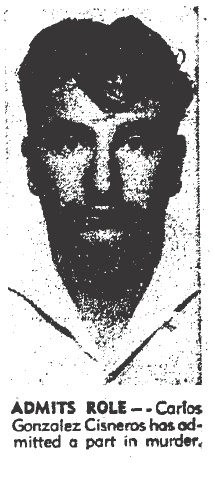 Because Allen and Carlos were incapable of keeping quiet about what they’d done it was only a matter of time before the law caught up with them. The remaining gang members began to fear Allen more than they did the cops. On June 17, 1960 Keith Slaten went to the police and a few days later Eugene Bridgeford did the same. The statements were enough for the police to get a warrant to examine Carlos’ Cadillac–they found traces of human blood in the trunk. One day later the police conducted a similar examination of Keith’s Ford and found human blood on the upholstery. On June 28, “sometime after 1:00 p.m.” Allen and Carlos were taken into custody.
Because Allen and Carlos were incapable of keeping quiet about what they’d done it was only a matter of time before the law caught up with them. The remaining gang members began to fear Allen more than they did the cops. On June 17, 1960 Keith Slaten went to the police and a few days later Eugene Bridgeford did the same. The statements were enough for the police to get a warrant to examine Carlos’ Cadillac–they found traces of human blood in the trunk. One day later the police conducted a similar examination of Keith’s Ford and found human blood on the upholstery. On June 28, “sometime after 1:00 p.m.” Allen and Carlos were taken into custody.